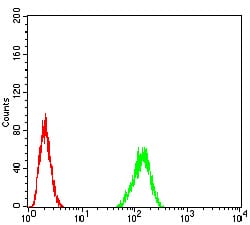

| WB | 咨询技术 | Human,Mouse,Rat |
| IF | 咨询技术 | Human,Mouse,Rat |
| IHC | 咨询技术 | Human,Mouse,Rat |
| ICC | 技术咨询 | Human,Mouse,Rat |
| FCM | 1/200 - 1/400 | Human,Mouse,Rat |
| Elisa | 1/10000 | Human,Mouse,Rat |
| Aliases | ALS10; TDP-43 |
| Entrez GeneID | 23435 |
| clone | 7F9A6 |
| WB Predicted band size | 44.7kDa |
| Host/Isotype | Mouse IgG1 |
| Antibody Type | Primary antibody |
| Storage | Store at 4°C short term. Aliquot and store at -20°C long term. Avoid freeze/thaw cycles. |
| Species Reactivity | Human |
| Immunogen | Purified recombinant fragment of human TARDBP (AA: 126-260) expressed in E. Coli. |
| Formulation | Purified antibody in PBS with 0.05% sodium azide |
+ +
以下是关于 **TARDBP抗体** 的3篇参考文献,简要概括如下:
---
1. **文献名称**: *TDP-43 in the ubiquitin pathology of frontotemporal dementia with ALS*
**作者**: Neumann M, et al.
**摘要**: 该研究首次报道TDP-43(由TARDBP基因编码)在额颞叶痴呆(FTLD-U)和肌萎缩侧索硬化症(ALS)患者脑组织中的异常聚集,并通过特异性抗体(如磷酸化TDP-43抗体)验证其病理特征,为TDP-43蛋白病提供了关键证据。
---
2. **文献名称**: *TARDBP mutations in familial and sporadic amyotrophic lateral sclerosis*
**作者**: Sreedharan J, et al.
**摘要**: 研究发现TARDBP基因突变可导致家族性和散发性ALS,并通过抗体验证突变型TDP-43蛋白的细胞质异常聚集,揭示了突变如何破坏RNA代谢并引发神经退行性病变。
---
3. **文献名称**: *Phosphorylated TDP-43 in frontotemporal lobar degeneration and ALS*
**作者**: Hasegawa M, et al.
**摘要**: 开发并验证了一种针对磷酸化TDP-43的特异性抗体,证明其在FTLD和ALS患者病理切片中可选择性标记异常磷酸化的TDP-43包涵体,为疾病诊断提供了重要工具。
---
如需更多文献或特定研究方向的补充,请进一步说明!
TARDBP antibodies target the TAR DNA-binding protein 43 (TDP-43), a multifunctional RNA/DNA-binding protein encoded by the *TARDBP* gene. TDP-43 is ubiquitously expressed and plays critical roles in RNA metabolism, including splicing, transport, and stability. Structurally, it contains two RNA-recognition motifs (RRMs) and a C-terminal prion-like domain, the latter being implicated in protein aggregation.
Pathologically, TDP-43 mislocalization and cytoplasmic aggregation are hallmarks of neurodegenerative diseases, notably amyotrophic lateral sclerosis (ALS) and frontotemporal lobar degeneration (FTLD). These aggregates are often hyperphosphorylated, ubiquitinated, or cleaved, serving as disease biomarkers. TARDBP antibodies are essential tools in research and diagnostics, enabling detection of TDP-43 pathology in cellular and tissue samples via techniques like immunohistochemistry (IHC), Western blot, and immunofluorescence.
Antibodies targeting specific TDP-43 epitopes (e.g., phosphorylated residues or disease-associated fragments) help distinguish pathological forms from normal protein. For example, antibodies like pS409/410-TDP-43 are used to identify phosphorylated aggregates in ALS/FTLD. However, variability in antibody specificity (e.g., clone 2E2-D3-A7-C6 vs. others) necessitates careful validation for experimental reproducibility.
Overall, TARDBP antibodies advance understanding of TDP-43’s dual roles in physiology and neurodegeneration, supporting therapeutic development and biomarker studies.
×